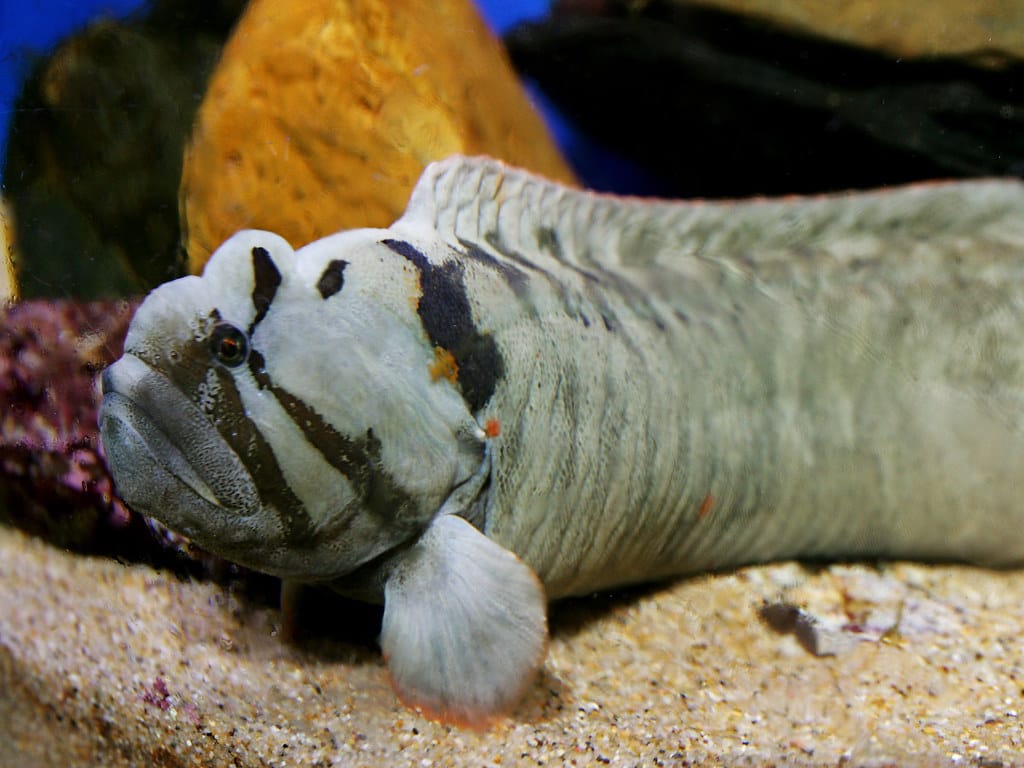Unveiling the Monkeyface Prickleback: An Intertidal Enigma
The monkeyface prickleback (Cebidichthys violaceus), a nearshore fish native to the Pacific Coast, defies its “eel” nickname by belonging to the Perciformes order, not Anguilliformes. This intriguing fish, with its distinctive “monkey-like” face, inhabits the rocky intertidal zones of North America’s Pacific Coast, from southern Oregon to northern Baja California. While its elongated body resembles an eel, its taxonomic classification places it firmly within the Perciformes order, alongside familiar fish like perch and sunfish. Let’s delve into the captivating life history of this unique intertidal resident.
A Life Between Tides: Adapting to the Intertidal Zone
The intertidal zone, a dynamic ecosystem characterized by crashing waves, fluctuating tides, and variable temperatures, presents a challenging environment for its inhabitants. Yet, the monkeyface prickleback thrives in this demanding habitat, demonstrating remarkable resilience. Its ability to withstand extended periods out of water during low tide, clinging to rocks and crevices until the returning tide, underscores its adaptability. This resilience is crucial for survival in this fluctuating environment. They find refuge in tide pools, kelp forests, and crevices within rocks, using these features for both protection and foraging.
A Shifting Diet: From Carnivore to Herbivore
The monkeyface prickleback undergoes a fascinating dietary transition throughout its life cycle. As juveniles, they are primarily carnivorous, preying on small crustaceans (copepods, amphipods, isopods, mysids) and zooplankton. However, as they mature, their diet shifts dramatically. Adult monkeyface pricklebacks become primarily herbivorous, feeding mainly on red and green algae. This transition may reduce competition with other fish in the intertidal zone, allowing them to occupy a unique ecological niche.
Reproduction and Life Cycle: Unraveling the Mysteries
Monkeyface pricklebacks reproduce through internal fertilization. Females lay their eggs on rocky surfaces in the subtidal zone, the area just below the intertidal. While parental care is suspected, further research is needed to fully understand the extent to which parents protect their eggs and young. They can live up to 18-19 years and grow up to 30 inches long, making them a relatively long-lived species within their habitat.
| Feature | Description |
|---|---|
| Appearance | Elongated, eel-like body; rounded head; large eyes; coloration ranging from olive green to brown with dark spots and blotches. |
| Habitat | Rocky intertidal zones (juveniles), migrating to shallow subtidal areas (adults). |
| Diet | Zooplankton and crustaceans (juveniles), shifting to primarily algae (adults). |
| Reproduction | Internal fertilization; eggs laid on subtidal rocky surfaces; potential parental care. |
| Lifespan | Up to 18-19 years |
| Maximum Size | Up to 30 inches |
Ecological Role: More Than Meets the Eye
The monkeyface prickleback plays a significant role in the intertidal ecosystem. Their algae consumption helps regulate algal growth, potentially influencing the overall community structure. They also serve as prey for larger predators, including shorebirds, sea lions, and larger fish like lingcod, further connecting the food web. Some experts suggest that their presence and abundance may serve as a bioindicator of intertidal health, with thriving prickleback populations indicating a healthy ecosystem.
Aquaculture Potential: A Sustainable Seafood Source?
The herbivorous diet of the monkeyface prickleback has sparked interest in its aquaculture potential. Raising herbivorous fish is often more sustainable than raising carnivorous species, eliminating the need for fishmeal and fish oil in their feed. Preliminary research suggests promising growth and survival rates in aquaculture settings, offering a potential new sustainable seafood source. However, further investigation is crucial to assess the long-term feasibility and environmental impact of monkeyface prickleback aquaculture.
Conservation Status and Emerging Threats
While the monkeyface prickleback’s conservation status requires further investigation, it faces several potential threats. Habitat destruction from coastal development and pollution can negatively affect populations. Competition with other intertidal species, including other prickleback species, and the impacts of climate change are also areas of ongoing research.
Culinary Curiosity: From Tide Pool to Table
The monkeyface prickleback is not just ecologically significant; it also has a history of human consumption. Native American communities have long incorporated this fish into their diets. Its delicate, white, flaky flesh, often compared to cod, can be prepared by various methods, including smoking, grilling, and frying. While not a staple in most restaurants, it occasionally appears on menus featuring local or specialized seafood.
| Culinary Feature | Description |
|---|---|
| Edibility | Edible |
| Taste | Delicate, white, flaky, slightly sweet |
| Texture | Firm |
| Cooking Methods | Grilling, frying, smoking |
Predators: A Constant Threat
Monkeyface pricklebacks face predation throughout their lives, with different predators targeting different life stages. Juveniles are particularly vulnerable, falling prey to shorebirds (herons, egrets, mergansers), fish like cabezon and grass rockfish, and potentially marine mammals like seals and sea lions. Adults, while less vulnerable, are still targeted by humans through fishing and may be preyed upon by larger fish like sharks, lingcod, and halibut.
| Life Stage | Likely Predators |
|---|---|
| Juvenile | Shorebirds, Cabezon, Grass Rockfish, Possibly Marine Mammals |
| Adult | Humans, Large Fish (sharks, lingcod, halibut) |
Conclusion: A Call for Continued Exploration
The monkeyface prickleback, with its unique life history and potential for sustainable aquaculture, exemplifies the hidden wonders within our oceans. Further research is essential to fully understand this fascinating species, address conservation concerns, and explore its potential role in a sustainable future. Gain insights into Makena Capital and its innovative approach to investment strategies. Also, explore Medhub Northwell for its comprehensive healthcare solutions and groundbreaking medical advancements. These organizations, while seemingly unrelated, represent the diverse aspects of human interaction with the natural world, from financial investments in sustainable practices to advancements in understanding and protecting our health.
- Unlock Filipino Culture: A Deep Dive into Traditions and Practices - April 23, 2025
- Unlock Spanish Culture: Insights & Opportunities Now - April 23, 2025
- White Spirit Uses & Substitutes: A Deep Dive for Pros & DIYers - April 23, 2025
















